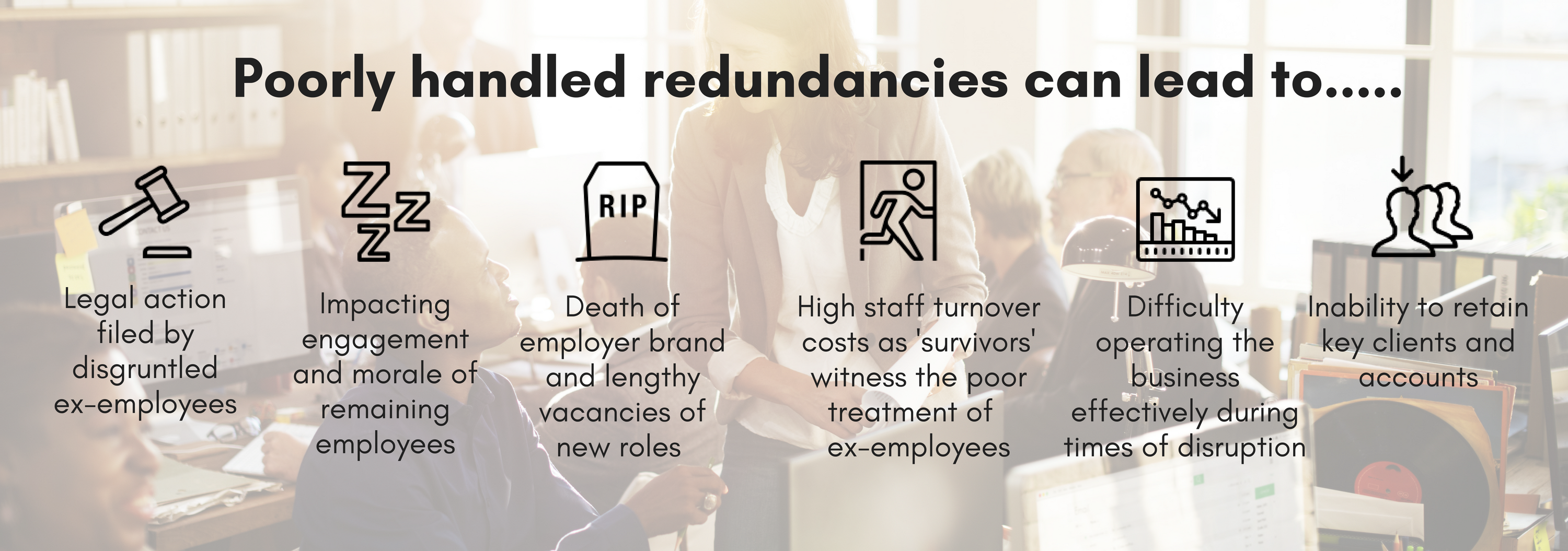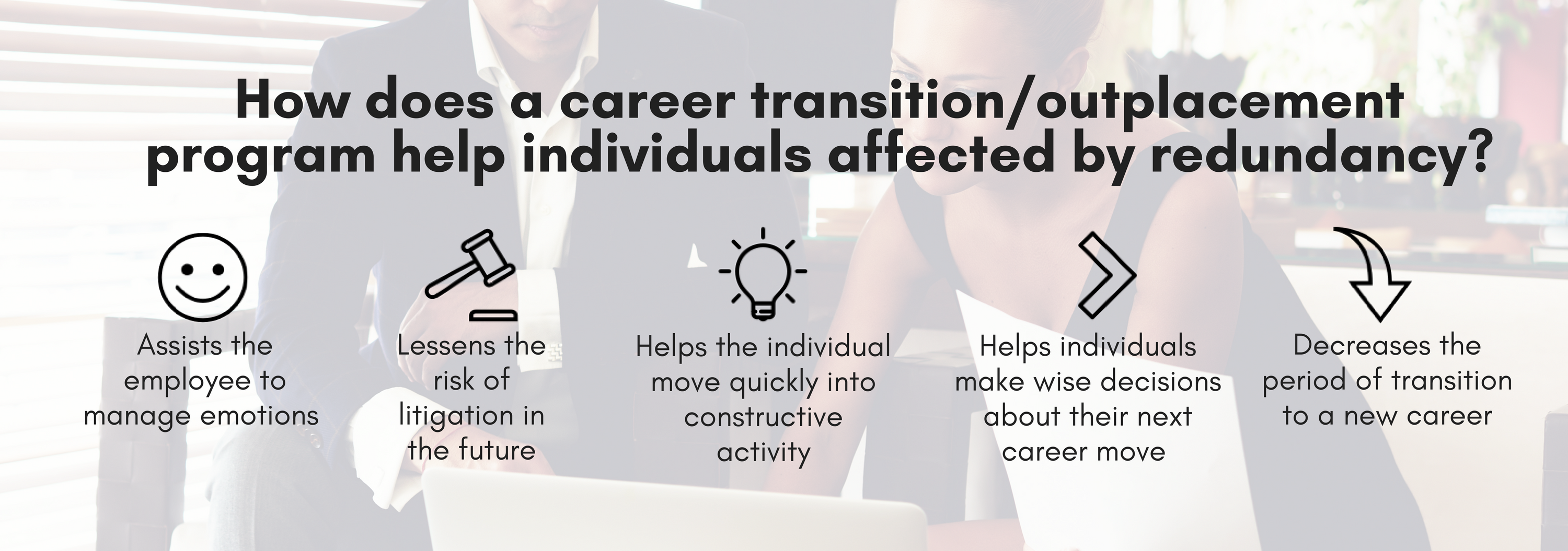The importance of career transition and outplacement services
Career transition occurs at many stages throughout an individual’s life, and is indicated by a change in role, organisation or industry (or all three!). Unplanned career change such as redundancy, stagnation in a role or changes in career goals can all lead to a career transition.
Table of Contents
- Why is it important to provide support to individuals experiencing career transition?
- What are career transition/outplacement services?
- What does a Career Transition program include?
- When should career transition/outplacement services be used?
- HR’s role in transitioning employees
- How to manage Career Transition
- How does a career transition/outplacement program work?
- How does a career transition/outplacement program help individuals following organisational change?
- Why should organisations provide career transition programs to their retrenched employees?
- Are career transition/outplacement programs confidential?
- Career transition/outplacement for individuals
- Trevor-Roberts career transition case studies
Why is it important to provide support to individuals experiencing career transition?
All transitions can be a time of heightened emotions and stress, and this is particularly true of redundancies. Some people may be expecting the news and some may even be hoping for it. Most of the time though people are shaken and concerned about what this will mean for them. Deeply personal questions about ‘who will I be now’, ‘what will others think of me’, ‘how will I provide for my family’, ‘was this my fault’ are raised during times of career transition and cannot be quickly or easily resolved. Despite these initial concerns, most individuals, especially those given professional support, can successfully move forward to transition to the next stage of their career. For some, it may even mean liberation to a new and better future - an opportunity to question one’s past model, or identity, and to forge a new career path.
For most individuals, a great deal of exploration and dialogue with others, including with their career transition provider, forms a part of this new journey. Creating the space to explore and reflect on professional strengths and new opportunities is critical. Of equal value is the provision of strategies to manage the complex range of emotions and challenges experienced during this time, as well as practical assistance to identify next steps and tools to conduct a successful job search.
___
“I am sorry, but we are going to have to let you go” can be a truly shattering event for most people.
___
What are career transition/outplacement services?
Employers typically engage Career Transition services to support affected individuals through retrenchments in a range of organisational change situations including technology advancements, downsizing, rightsizing and site shutdowns.
Following a job loss or an employee’s decision to move on, a career transition program assists an individual to identify preferred career directions, how to build and establish strong networks and identify what skills (both technical and leadership) need to be developed and creating resilience for the future.
eBook: A how-to guide for restructures & redundancies
What does a Career Transition program include?
Programs vary in duration, content, design, the seniority of the consultants and the resources provided. The details of a program depend on the type of program that the employer has chosen for the affected employee and the specific needs of the individual.
Although career transition programs differ from provider to provider, a standard program typically consists of career coaching, access to group workshops and online resources to assist the individual to find their next role.
Within the coaching sessions, a career coach assists the individual to explore possible career options for the future, understand their skills, interests and preferences, develop resumes and cover letters, identify and apply for suitable jobs, prepare for interview and use platforms such as LinkedIn to advance their job search.
As technology continues to advance, skype consultations and online offerings are becoming more widely available to clients based in remote locations.
The content of a program, covered with a career coach across multiple sessions, incorporates some or all of the below:
.png?width=3060&name=what%20is%20included%20in%20a%20career%20transition%20program_%20(1).png)
When should career transition/outplacement services be used?
Organisational change and the need for career transition support may be triggered by a host of different factors:
![]()
Mergers, acquisitions & divestments
![]()
Downsizing
![]()
New business ventures
![]()
Geographic and international growth (or retreat)
![]()
Restructuring
![]()
Shifts in markets and services
HR’s role in transitioning employees
When it is decided by management that organisational change will occur, human resources professionals are relied upon to handle the bulk of the work. To shape communications, advise on new organisational structures, associated accountabilities, remuneration options and redeployment options. Another key element of the HR role in times of redundancies is to develop the policies and programs around the treatment and relocation of affected employees. What’s more, ensuring effective governance over formal obligations in times of change can be a difficult task. Poorly thought through, albeit well-intentioned, actions can seriously impact a major change project.
There is, however, another critical accountability, that is often less considered by organisations. That is the guidance of managers in dealing with the human aspects of an organisational change.
___
The objective here is to guide change with humanity.
___
How to manage Career Transition
Many managers and HR professional say that retrenching an employee is one of the most difficult tasks that they have faced.
Offering career transition programs to individuals affected by organisational change is best practice and ensures the ‘human’ element of a restructure is handled respectfully.

There are 5 elements that will assist you to retrench an employee with dignity and ensure your organisation avoids these consequences – you can read more on these here.
It is important to keep in mind that communication regarding the changes, monitoring how the changes are affecting employees and looking after your team, your managers and yourself is important throughout the change process.
___
One of the single most important tasks for executives leading through a restructure is the creation of a compelling narrative for the new future.
___
This narrative is essential when it comes to guiding both the behaviours of an organisation’s employees, and their understanding of what is expected of them after a period of change. A narrative for the new future is also necessary to serve as a guide for employees’ understanding of the organisation’s strategy.
Choosing to lead with optimism during these difficult times can give employees the motivation and commitment to take advantage of the potential opportunities that lie ahead, rather than getting caught up in negativity and dwelling on the uncertainty of their role.
How does a career transition/outplacement program work?
Via face-to-face meetings or Skype sessions with a career coach, a career transition program gives individuals the tools, support and knowledge required to navigate through this challenging transition period.
From the time of redundancy, an individual will generally have several weeks or months to take up the program, depending on the outplacement provider. This time allows individuals to move through the emotions and feelings associated with the job loss and start the process when they feel up to it.
How does a career transition/outplacement program help individuals following organisational change?

The overwhelming feedback we receive is that by helping program participants to transform their careers, we are also empowering them to transform their lives.
The individuals who use our programs come away with a direction for the future and a roadmap to get there. With our Career Transition programs, we see our customers improve not only their skills and capabilities, but also develop a new approach to the job market. We provide our customers with the tools to succeed, and as a result they become more effective in the job market and secure new opportunities quicker.
Why should organisations provide career transition programs to their retrenched employees?
![]()
Avoid the negative impacts of organisational change on employees
Organisational changes can create significant stress and uncertainty for individuals simply through the way they are treated. Companies can turn into transactional, disengaged workplaces by the cumulative effect of insensitive, impersonal actions and omissions. This can end in cynicism for remaining employees as they observe these same companies promoting new values around people and integrity in a cultural “rebirth”.
Offering career transition support to those affected can work to counter or reduce the likelihood of ‘survivors’ feeling that their former colleagues were mistreated.
![]()
Protects from litigation
Providing your employees with programs that can assist them to move to the next stage of their career will help demonstrate your commitment to fulfilling your corporate responsibility to them. The one-on-one career coaching and workshops help affected individuals look toward the future, rather than dwelling on the past. In most cases, this support demonstrates that your organisation is fair and supportive and decreases the likelihood of litigation from disgruntled ex-employees. When managing redundancies, it is important to put as much effort as you can into supporting those who have been affected by it.
Upholds your employer brand
Having outplacement services in place assists to protect your employer brand in the eyes of investors, customers, employees and future candidates, as it shows that you care for your staff and their future. By concentrating on moving forward and helping your employees to do the same, your organisation demonstrates professionalism, focus and dedication in supporting its current and past employees – attributes that will only help to enhance your employer brand into the future.
Ensures productivity & morale from remaining staff
Often after organisational change, the ‘survivors’ that remain can feel disheartened, angry or even worried about their own future careers. This can affect their motivation and dedication to the company, as well as their productivity. Treating affected employees with dignity and respect can also work to reassure your staff and encourage them to feel confident again in the work that they do by showing your concern and support, and offering outplacement services.
Are career transition/outplacement programs confidential?
Once career coaching begins with an individual, the process is confidential (in order to build trust of the participant, and to ensure that absolutely frank and fearless advice is given where necessary). General feedback only as to the broad progress of each individual is provided back to the organisation and only in instances where the organisation has funded the program.
Career transition/outplacement for individuals
Individuals who are looking to transition from an organisation they no longer wish to be a part of may also engage a career transition provider. The only difference is that the individual will cover the cost of the service, rather than the individual’s employer.
Click here for specific information on our Career Transition/Outplacement services for individuals
